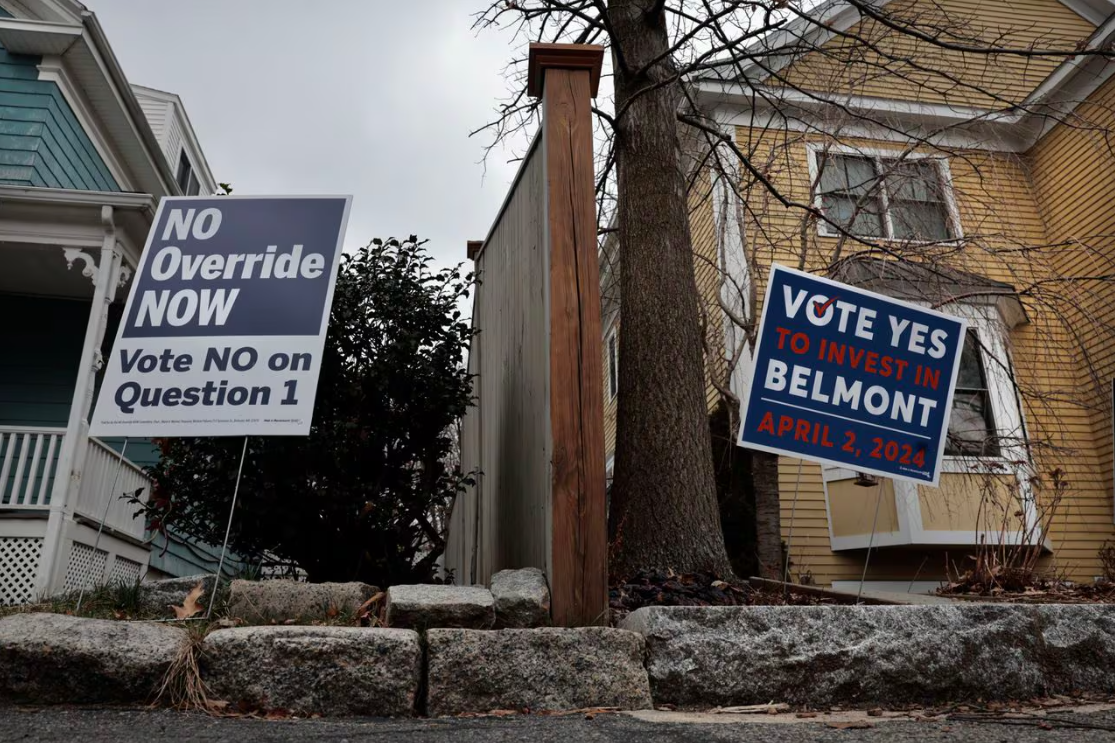马萨诸塞州学校经费改革遇到通货膨胀问题

【中美创新时报2024年3月13日波士顿讯】(记者温友平编译)马萨诸塞州立法者彻底改革该州的学校资助公式近五年后,各学区正在努力平衡即将到来的学年的预算,促使许多人考虑削减项目和人员或要求纳税人进行更深入的研究。《波士顿环球报》记者詹姆斯·瓦兹尼斯(James Vaznis)对此作了下述详细报道。
马萨诸塞州立法者彻底改革该州的学校资助公式近五年后,各学区正在努力平衡即将到来的学年的预算,促使许多人考虑削减项目和人员或要求纳税人进行更深入的研究。
地区领导人和支持者表示,罪魁祸首是近年来对美国经济造成的高通货膨胀率,远高于为反映现代成本而修改的新融资公式中使用的调整。
无党派研究机构马萨诸塞州预算和政策中心副政策主任科林·琼斯表示,新公式未能准确反映通货膨胀情况,可能会导致各地区总共损失数亿美元的援助费用。
贝尔蒙特、哈佛和韦斯特福德的选民将在今年春天的投票中考虑大幅提高财产税,如果未能通过,可能会导致学校和城镇服务的大幅削减。例如,在贝尔蒙特,如果选民在 4 月 2 日否决 840 万美元的超额拨款,学校领导表示,他们将需要关闭玛丽·李·伯班克小学,取消数十个教学和其他职位,并大幅削减课外活动。
“这令人心碎,”萨曼莎·图 (Samantha Thu) 说,她小时候去了伯班克,有一个女儿在那里上二年级,另一个女儿将于今年秋天上幼儿园。 “这对我们来说绝对是动荡的几个月。”
如果超控失败,学校将在 2025-26 学年关闭。周四说,她还不知道孩子们会被分配到哪所学校。贝尔蒙特目前有五所小学。
学区最大的成本增长包括健康保险费、校车合同、特殊教育服务和公用事业。在大流行关闭后学校重新开学后不久,许多人就开始感受到财政紧缩,最初能够利用现已耗尽的联邦刺激资金在不同程度上缓解财政紧缩。其他地区已经颁布了削减措施或要求选民推翻该州每年财产税增长的上限。
霍普代尔的学校校长凯伦·克雷巴斯 (Karen Crebase) 表示:“许多学区都感觉自己正在陷入财政悬崖。” 2023 年,镇选民批准增税 135 万美元,以维持学校项目并防止镇图书馆、公园部门和老龄化委员会关闭。镇领导曾考虑在今年寻求另一次推翻,但现在相信他们不需要推翻也能过得去。
尽管州长莫拉·希利 (Maura Healey) 提议为下一学年提供近 70 亿美元的国家教育援助,比今年的拨款增加了 2.6 亿多美元,但财政困难仍在加剧。
不断上涨的成本甚至让该方案旨在受益最多的地区陷入困境:那些拥有大量高需求学生、家庭收入水平和财产税基数较低的地区。几乎一半的学校资金流向了这些地区,其中包括布罗克顿和其他几十个地区。
布罗克顿学校领导最近警告称,今年的预算缺口在 1,900 万至 2,500 万美元之间,主要是由于意外成本,其中包括超过 2,200 万美元的交通支出,是预算金额的两倍多。紧接着去年出现了 1830 万美元的赤字,迫使该市救助学校系统。
布罗克顿今年获得了 2.41 亿美元的州教育援助,在该州排名第五,预计明年还将获得 1500 万美元的额外援助。根据州规定,援助金额约占布罗克顿所需学校支出的 80%。
然而,一份受州教育部委托的第三方咨询报告发现了财务管理不善的证据,包括控制不足、未能迅速解决意外支出缺口以及记录保存不善。问题如此严重,下一学年的预算缺口可能达到 1900 万美元。
市长罗伯特·F·沙利文称这些问题“不可接受”,并发誓要建立“保障措施,确保类似情况不再发生”。
教育执行办公室发言人表示,希利政府为其提议的援助进行了辩护,称其“正在提供历史水平的资金,以确保我们的 K-12 学校能够公平地获得学生和教育工作者所需的资源”。
当州立法者于 2019 年 11 月对学校经费进行全面改革时,由于未能准确预测学校成本,该公式每年给学区带来了约 10 亿美元的损失。这迫使各地区,特别是经济困难地区,削减教师、教室用品和建筑维护费用。
此次改革被称为《学生机会法》,旨在通过修改公式以反映实际的学校支出并向学校投入更多资金来解决这一问题。到目前为止,该法律已为当地地区带来了超过 13 亿美元的额外资金。根据州教育部备忘录,该计划还保证各学区每年为每位学生增加至少 30 美元的收入。根据马萨诸塞州学校校长协会编制的数据,根据希利的预算提案,212 个学区将获得最低补助。
但监管协会表示,过去两年,政府用于计算大部分所需成本的通胀率太低,为 4.5%。根据国家关于通货膨胀率的通知,这是学校资助法允许的最高限额,但员工健康福利除外,该福利没有上限。
但根据学监协会的数据,本财年学校的实际通货膨胀率为 8%,上一财年为 7%。
该协会表示,虽然下一学年的通货膨胀率预计会低得多,约为 1.35%,但预算问题仍然存在,因为之前较高的成本现在已计入他们的开支中。
在戴德姆,学校领导面临着明年预算可能被削减的问题,尽管国家援助有望增加 39%。推动这一增长的是学生入学人数的增长。但该镇仍在努力克服前几年的通货膨胀。
“该学区将不得不大幅裁员,”戴达姆学区负责人南·墨菲 (Nan Murphy) 说。
拥有优先权的城镇中的一些居民反对为学校缴纳更高的税款。
“我们受够了,”贝尔蒙特“禁止凌驾”运动的志愿者道恩·麦凯伦 (Dawn MacKerron) 说。 “他们不能继续利用纳税人来纾困。”
但贝尔蒙特投资活动的艾琳·罗兰表示,被拒绝的风险太大了。
“我们的社区将永远变得更糟,”她说。 “该镇将不得不全面实施极具破坏性的服务削减——公共安全、学校和其他关键服务。”
超控拒绝的连锁反应可能是巨大的。在牛顿,去年 920 万美元的税收减免失败在今年冬天为期两周的教师罢工期间反复出现,因为他们的工会敦促加薪。根据希利的预算提案,牛顿获得的国家援助将增加 1.8%,即每名学生增加 42 美元,使其总额达到近 2800 万美元。
联合教育委员会联合主席、参议员贾森·刘易斯表示,灯塔山的立法者正在讨论潜在的补救措施。他说,短期内,立法机关可能会将希利预算提案中每个学生的最低援助增加额增加一倍,达到下一个财政年度的 60 美元,立法者在本财政年度也这样做了。
他说,长期解决方案更加复杂,可能包括采取更多措施来帮助目前获得最低增幅的地区,并指出公式中衡量社区支付能力的部分主要基于家庭收入水平和财产税收入 ,已经过时了。
但他补充说,“没有任何融资方案是完美的。”
题图:邻居们对贝尔蒙特的第一个问题表达了反对意见。CRAIG F. WALKER/GLOBE STAFF
附英文原文报道:
Massachusetts school funding overhaul hits an inflation glitch
By James Vaznis Globe Staff,Updated March 12, 2024
Nearly five years after Massachusetts lawmakers overhauled the state’s school funding formula, districts are struggling to balance their budgets for the upcoming school year, prompting many to consider cutting programs and staff or asking taxpayers to dig deeper.
The chief culprit, district leaders and advocates say, is the high rate of inflation that hit the US economy in recent years, much higher than the adjustments used in the new funding formula that was revamped to reflect modern-day costs.
The failure of the new formula to accurately capture inflation could be collectively costing districts hundreds of millions of dollars in aid, according to Colin Jones, deputy policy director at the Massachusetts Budget and Policy Center, a nonpartisan research institute.
Voters in Belmont, Harvard, and Westford will be considering hefty property tax hikes at the polls this spring, which, if they fail to pass, could result in significant cuts to school and town services. In Belmont, for example, if voters reject an $8.4 million override on April 2, school leaders have said they will need to close the Mary Lee Burbank Elementary School, eliminate dozens of teaching and other positions, and make deep cuts to extracurricular activities.
“It’s heartbreaking,” said Samantha Thu, who went to the Burbank as a child and has a daughter in second grade there and another daughter who will attend kindergarten this fall. “It’s definitely been a turbulent few months for us.”
If the override fails, the school would close for the 2025-26 school year. Thu said she doesn’t know yet which school her children would be assigned to. Belmont currently has five elementary schools.
The biggest cost increases hitting school districts include health insurance premiums, school bus contracts, special education services, and utilities. Many began feeling the fiscal pinch soon after schools reopened after the pandemic shutdown, and were initially able to mitigate it to varying degrees with federal stimulus dollars that are now running out. Other districts have already enacted cuts or asked voters to override the state’s cap on annual property tax increases.
“Many districts feel like they are going off a fiscal cliff,” said Karen Crebase, the school superintendent in Hopedale. Town voters in 2023 approved a $1.35 million tax hike to maintain school programs and prevent the closing of the town library, the parks department, and the council on aging. Town leaders contemplated seeking another override this year, but now believe they can get by without one.
The financial difficulties are flaring up even though Governor Maura Healey has proposed nearly $7 billion for state education aid for the next school year, an increase of more than $260 million over this year’s allocations.
The rising costs have even ensnared districts the formula was engineered to benefit the most: those with large portions of high-need students and low household-income levels and property tax bases. Almost half of school funding goes to those districts, which include Brockton and a few dozen others.
Brockton school leaders recently warned of a budget shortfall between $19 million and $25 million for the current year due largely to unanticipated costs, including more than $22 million in transportation spending — more than double the budgeted amount. The shortfall comes on the heels of an $18.3 million deficit last year, which forced the city to bail out the school system.
Brockton is receiving $241 million in state education aid this year — the fifth highest in the state — and is expected to receive an additional $15 million next year. The aid amount covers about 80 percent of Brockton’s required school spending under the state formula.
However, a third-party consulting report, commissioned by the state Education Department, found evidence of financial mismanagement, including inadequate controls, failure to quickly address unexpected spending gaps, and poor record keeping. The problems are so severe that the budget shortfall for the next school year could reach $19 million.
Mayor Robert F. Sullivan called the problems “unacceptable” and vowed to establish “safeguards to ensure that nothing like this happens again.”
The Healey administration defended its proposed aid, saying it is “delivering historic levels of funding to ensure our K-12 schools have equitable access to the resources their students and educators need,” said a spokesperson for the executive office of education.
When state lawmakers overhauled school funding in November 2019, the formula had been shortchanging districts by about $1 billion a year by failing to accurately project school costs. That forced districts, especially in economically distressed areas, to cut teachers, classrooms supplies, and building maintenance.
The overhaul, known as the Student Opportunity Act, aimed to remedy that by revamping the formula to reflect actual school spending and devoting more money to schools. So far, the law has generated more than $1.3 billion in extra funding to local districts. It also guarantees districts will receive at least $30 more per student each year, according to state Education Department memos. Under Healey’s budget proposal, 212 districts would receive the minimum, according to data compiled by the Massachusetts Association of School Superintendents.
But for the last two years, the superintendents association said, the inflation rate the state used to calculate most required costs was far too low, 4.5 percent. That’s the highest allowed under the school funding law, excepting employee health benefits, which have no cap, according to the state notices on the inflation rates.
But actual inflation for schools was 8 percent for this fiscal year and 7 percent for the last fiscal year, according to the superintendents association.
While inflation for the next school year is projected to be much lower, about 1.35 percent, the association said, the budget problems persist because those earlier higher costs are now built into their expenses.
In Dedham, school leaders are confronting potential budget cuts for next year, even though it is poised to receive a 39 percent increase in state aid. Driving the increase is student enrollment growth. But the town is still struggling to overcome inflation from previous years.
“The district will have to make significant personnel reductions,” said Dedham superintendent Nan Murphy.
Some residents in the towns with overrides oppose paying higher taxes for the schools.
“Enough is enough,” said Dawn MacKerron, a volunteer with the no override campaign in Belmont. “They can’t keep tapping taxpayers to bail them out.”
But Erin Rowland of the Invest in Belmont campaign said the stakes of a rejection are too high.
“Our community will be permanently changed for the worse,” she said. “The town will have to implement very devastating service cuts across the board — public safety, the schools, and other critical services.”
The ripple effects of override rejections can be huge. In Newton, the defeat of a $9.2 million tax override last year repeatedly came up during the course of a two-week teachers strike this winter, as their union pressed for pay raises. Newton would receive a 1.8 percent increase in state aid, or $42 more per student, under Healey’s budget proposal, bringing its total to nearly $28 million.
Beacon Hill lawmakers are debating potential remedies, said Senator Jason Lewis, cochair of the Joint Education Committee. In the short term, he said, the Legislature might double the minimum per-student increase in aid in Healey’s budget proposal to $60 just for the next fiscal year, which lawmakers also did for this fiscal year.
Long-term solutions, he said, are more complicated and could include doing more to help districts that currently receive minimum increases, noting that the part of the formula that measures a community’s ability to pay, based largely on household income levels and property tax revenue, is outdated.
But he added, “no funding formula is going to be perfect.”

